Trees, shrubs or rarely perennial herbs. Leaves imparipinnate, 8–36(–64)-foliolate; stipels setaceous or often absent; leaflets 0.5–5(–9) cm. long. Flowers in terminal or axillary few-to many-flowered racemes; bracts often fairly large; bracteoles small when present, but usually apparently absent; pedicels often swollen or jointed near the top. Hypanthium often well developed. Calyx campanulate to tubular, with very shallow to prominent and acute lobes, the upper 2 often fused. Petals yellow, white, blue or purple, up to 5 cm. long; standard usually narrowed into a short claw, the limb ± reflexed; wings ± obliquely oblong; keel-petals usually overlapping or joined on the lower side. Stamens free or shortly joined at the base; anthers dorsifixed. Ovary shortly stipitate, with several to numerous ovules; style incurved, with a small terminal stigma. Fruit moniliform, often winged, 1–14-seeded, dehiscent or coriaceous to fleshy and indehiscent. Seeds obovoid or globose, usually with a small hilum; radicle straight or incurved.
Deciduous or evergreen trees, shrubs, subshrubs, or perennial herbs, rarely twining. Leaves imparipinnate; stipules present or absent; leaflets many, entire, rarely with stipels. Racemes terminal or axillary. Flowers white, yellow, or purple; bracts small and linear or absent. Calyx campanulate or cup-shaped, 5-lobed, equal, upper 2 lobes nearly bilabiate. Standard orbicular, oblong, elliptic, obovate, or oblanceolate; wings asymmetric or symmetric; keel similar to wings. Stamens 10, free or fused at base; anthers versatile. Ovary stalk short or absent; ovules several to many; stigma small, terminal, globose. Legumes cylindric, moniliform, fleshy or leathery, sometimes winged, indehiscent or tardily dehiscent. Seeds 1 to many, ovate, elliptic, or subspheroidal, black, dark brown, or light red.
Fls large, racemose or panicled; calyx oblique, teeth short; standard broad, wings < keel. Stamens 10, free. Ovary stipitate, ovules ∞; style incurved, stigma terminal. Pods moniliform, elongate, terete or 4-winged, coriac. to woody, ind. or dehiscent by valves. Seeds ± globose, testa hardened. Trees or shrubs with imparipinnate lvs. About 30 spp. of temperate and subtropical regions in both hemispheres. The N.Z. spp. are endemic.
Petals yellow, white, blue or purple, small to rather large; standard usually gradually narrowed below into a short claw, the limb ± reflexed; keel petals overlapping or joined on the lower side.
Inflorescences terminal or axillary, consisting of few-to many-flowered racemes; bracts often fairly large; bracteoles small when present but usually apparently absent.
Seeds ovoid, ellipsoid or globose, usually without a distinct radicular lobe and with a small hilum; radicle short, ± straight or incurved.
Calyx campanulate to tubular, with very shallow to prominent and acute lobes, the upper 2 often fused.
Leaves imparipinnate, with 4–18(32) leaflets per side, glabrous to densely tomentose; stipels absent.
Pod moniliform, often winged, with 1–14 seeds, dehiscent or tardily breaking up irregularly.
Stamens free to shortly joined at the base; anthers dorsifixed.
Flowers markedly perigynous, with a distinct hypanthium.
Trees or shrubs or rarely perennial herbs.
Ovary shortly stalked.


